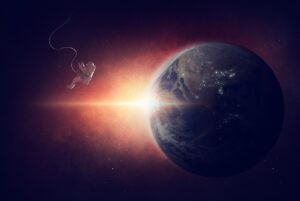Imagine a time when the night sky was dominated by a Moon that loomed ten times larger than what we see today—a celestial spectacle that would have left ancient observers awestruck. The Moon has always been with us, like a loyal friend, in the big story of the universe. But the Moon has its own incredible tale to tell.
Here are 10 incredible facts about the moon to help you understand its mysteries:
1. Moon’s Explosive Beginning
Scientists believe the Moon formed after a big crash between early Earth and a Mars-sized object called ‘Theia.’ Debris from this crash came together to make the Moon. This idea, known as the ‘Giant Impact Hypothesis,’ happened about 4.5 billion years ago, not 100 million times bigger than the event that ended the dinosaurs.
2. It Used to Look Larger
A long time ago, the Moon was much closer to Earth and appeared around ten times bigger in the sky. Computer models suggest it might have been even closer—about 12-19 times nearer—than its current distance of 384,000km. The Moon is moving away slowly because of Earth’s movements.
3. The Mysterious Smell of Moon Dust
Moon’s surface has lots of dust, and Apollo astronauts noticed it on their suits. One astronaut, Harrison ‘Jack’ Schmitt, said it smelled like gunpowder. Some astronauts got a kind of ‘lunar hay fever’ from it, which took days to go away.
4. Extreme Temperatures on the Moon
The Moon doesn’t have air to protect it, so its surface gets super hot on the sunny side and very cold on the night side. NASA says it can range from 123 degrees Celsius to -233 degrees Celsius. Daytime is around 107 degrees Celsius, and nighttime is about -153 degrees Celsius.
5. Craters Tell Space History

Because the Moon lacks air, it’s full of craters from meteor hits. These craters help us learn about space’s history. There are millions of craters on the Moon, including 5000 bigger than 20km across. The Moon stores evidence of ancient happenings because it doesn’t have things like volcanoes and erosion.
6. We Only See One Side of the Moon
Similar to Earth, the Moon also rotates around its axis. However, it takes about 27 days for the Moon to complete one orbit around Earth. This unique timing results in a phenomenon called ‘tidal locking,’ which makes us see only one side of the Moon from Earth. Before humans ventured into space, the other side of the Moon remained entirely unseen.
7. Moon Causes Tides
The Moon’s gravity creates bulges in Earth’s water, causing tides. Water on the side facing the Moon bulges, while the side farther from the Moon bulges the opposite way. This causes high and low tides as the Earth rotates.
8. There is Water on the Moon
Water has been found on the Moon by missions like Chandrayaan-1 and NASA. It’s not much, but it could help with future Moon bases.
9. The Nebra Sky Disc and the Moon’s Impact on History
A remarkable relic, the Nebra Sky Disc, reveals how the Moon has shaped human history. In a fascinating episode, a lunar eclipse in 1504 played a crucial role in Christopher Columbus’s story. The eclipse frightened local inhabitants, compelling them to provide Columbus and his crew with much-needed food.
10. Moon Bases in the Future
While it might be centuries before many people live on the Moon, scientists think we could have research bases like in Antarctica. NASA plans to send astronauts back by the late 2020s. The Moon’s vast surface could offer many possibilities for science and discovery.